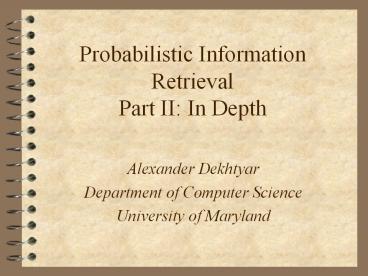Probabilistic Information Retrieval Part II: In Depth - PowerPoint PPT Presentation
Title:
Probabilistic Information Retrieval Part II: In Depth
Description:
Binary Independence Retrieval (BIR) Estimating the probabilities ... 'Independence': terms occur in documents independently ... term independence. terms not in ... – PowerPoint PPT presentation
Number of Views:193
Avg rating:3.0/5.0
Title: Probabilistic Information Retrieval Part II: In Depth
1
Probabilistic Information RetrievalPart II In
Depth
- Alexander Dekhtyar
- Department of Computer Science
- University of Maryland
2
In this part
- Probability Ranking Principle
- simple case
- case with retrieval costs
- Binary Independence Retrieval (BIR)
- Estimating the probabilities
- Binary Independence Indexing (BII)
- dual to BIR
3
The Basics
- Bayesian probability formulas
- Odds
4
The Basics
- Document Relevance
- Note
5
Probability Ranking Principle
- Simple case no selection costs.
- x is relevant iff p(Rx) gt p(NRx)
- (Bayes Decision Rule)
- PRP in action Rank all documents by p(Rx).
6
Probability Ranking Principle
- More complex case retrieval costs.
- C - cost of retrieval of relevant document
- C - cost of retrieval of non-relevant document
- let d, be a document
- Probability Ranking Principle if
- for all d not yet retrieved, then d is the next
document to be retrieved
7
Next Binary Independence Model
8
Binary Independence Model
- Traditionally used in conjunction with PRP
- Binary Boolean documents are represented as
binary vectors of terms - iff term i is present in document
x. - Independence terms occur in documents
independently - Different documents can be modeled as same
vector.
9
Binary Independence Model
- Queries binary vectors of terms
- Given query q,
- for each document d need to compute p(Rq,d).
- replace with computing p(Rq,x) where x is vector
representing d - Interested only in ranking
- Will use odds
10
Binary Independence Model
- Using Independence Assumption
11
Binary Independence Model
- Since xi is either 0 or 1
Then...
12
Binary Independence Model
13
Binary Independence Model
14
Binary Independence Model
- All boils down to computing RSV.
So, how do we compute cis from our data ?
15
Binary Independence Model
- Estimating RSV coefficients.
- For each term i look at the following table
16
PRP and BIR The lessons
- Getting reasonable approximations of
probabilities is possible. - Simple methods work only with restrictive
assumptions - term independence
- terms not in query do not affect the outcome
- boolean representation of documents/queries
- document relevance values are independent
- Some of these assumptions can be removed
17
Next Binary Independence Indexing
18
Binary Independence Indexing vs. Binary
Independence Retrieval
- BIR
- BII
- Many Documents, One Query
- Bayesian Probability
- Varies document representation
- Constant query (representation)
- One Document, Many Queries
- Bayesian Probability
- Varies query
- Constant document
19
Binary Independence Indexing
- Learnng from queries
- More queries better results
- p(qx,R) - probability that if document x had
been deemed relevant, query q had been asked - The rest of the framework is similar to BIR
20
Binary Independence IndexingKey Assumptions
- Term occurrence in queries is conditionally
independent - Relevance of document representation x w.r.t.
query q depends only on the terms present in the
query (qi1) - For each term i not used in representation x of
document d (xi0) - only positive occurrences of terms count
21
Binary Independence Indexing































